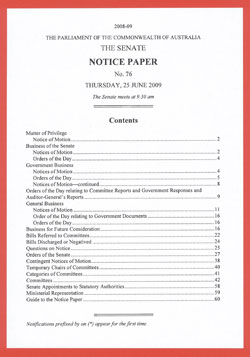59 Government and general business
Government business shall take precedence of general business, except that general business shall take precedence of government business on Thursday at the time provided, for a period not exceeding 2 hours, and general business orders of the day shall take precedence of general business notices of motion on alternate Thursdays.
Amendment history
Adopted: 21 November 1989, J.2219 as SO 59 (with effect from the first sitting day in 1990) (previously dealt with by sessional orders; incorporated into standing orders as part of the 1989 revision)
Amended: 13 February 1997, J.1447 (to take effect 24 February 1997) (incorporation of 1994 reforms to routine of business)
Commentary

The hierarchy of business established by the standing orders is reflected in the organisation of the Notice Paper
The first version of SO 59 was adopted by the Senate on 5 June 1901 as a sessional order after a lengthy debate about the hours of meeting, particularly the commencement time on Fridays, and the routine of business. It provided for government business to take precedence over general business on Wednesdays and Thursdays, and after the “dinner hour” on Fridays (see SO 55). Only questions would precede such business but an amendment added “Formal Motions” as well, and there was extensive debate about the meaning of this term (see SO 66).[1]
The order has existed in various forms continuously since 1901 and has been adapted to accommodate business pressures, such as the end of sitting accumulation of bills when time for general business was (and remains) likely to be dispensed with altogether.[2] Although the time now set aside specifically for general business seems modest in comparison with earlier days, the availability of additional opportunities to debate documents, committee reports and Auditor-General’s reports, for example, has resulted in the average time spent on general business continuing to be about half the time spent on government business.[3]
In its current form, the standing order reflects changes to the routine of business in 1994 to provide for general business to commence not later than 4.30 pm on Thursdays. This was incorporated in general terms (“at the time provided”) in the 1997 consolidation.[4] It also encompasses another longstanding practice, first adopted as a sessional order in 1901, for general business notices of motion and orders of the day to take precedence in alternate weeks.[5] When there was little general business on the Notice Paper, it was reasonable to expect that most of it could be dealt with during a general business session, with the Clerk calling on each item of business in the order in which it appeared on the Notice Paper. Starting with either notices of motion or orders of the day in alternate weeks ensured a balance between opportunities to debate new business and adjourned business.
Contemporary practice is for general business opportunities to be shared amongst the non-government parties by informal agreement and approximately in proportion to the representation of non-government parties and independents in the Senate. A motion to rearrange business is used to select which particular item or items of general business will be called on during the time provided. The motion is moved by a minister without notice under the authority of SO 56. This practice effectively supersedes the procedure for alternating between notices of motion and orders of the day and calling them on in sequence.
While general business provides an opportunity for the non-government parties to choose the topic of debate, in practice decision-making is limited by the restriction on divisions after 4.30 pm on Thursdays (see SO 57).